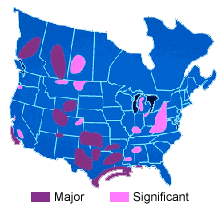A little on Natural Gas
Natural gas is one of the cleanest commercial fuels available since it produces only carbon dioxide, water vapor and a small amount of nitrogen oxides when burned. Unlike the combustion of other fossil fuels, natural gas combustion does not produce ash residues or sulfur dioxides. Natural gas is the most environmentally benign burning domestic energy source widely available that powers our economy. It cools and warms our homes and businesses, it’s used to cook, used for washing and drying, and used to generate electricity. There is currently a growing movement for natural gas to fuel our cars. The bottom line is that natural gas helps maintain our quality of life.
Discovery
Some scholars speculate that people living in the Middle East discovered this property of natural gas between 6000 and 2000 BC when lightning strikes ignited natural gas seeping from the ground. The Chinese burned natural gas as early as 211 BC to dry rock salt found in limestone rock. They also drilled the first known natural gas wells, using bamboo poles and primitive bits, but back then, they were only able to reach depths of 500 feet.
How is Natural Gas Formed?
- Stage 1 – All of the natural gas we use today began as microscopic plants and animals living in the ocean millions of years ago. As these microscopic plants and animals lived, they absorbed energy from the sun, which was stored as carbon molecules in their bodies. When they died, they sank to the bottom of the sea. Over millions of years, layer after layer of sediment and other plants and bacteria were formed.
- Stage 2 – As they became buried ever deeper, heat and pressure began to rise. The amount of pressure and the degree of heat, along with the type of biomass, determined if the material became oil or natural gas. Very high heat or biomass made predominantly of plant material produced natural gas.
- Stage 3 – After oil and natural gas were formed, they tended to migrate through tiny pores in the surrounding rock. Some oil and natural gas migrated all the way to the surface and escaped. Other oil and natural gas deposits migrated until they were caught under impermeable layers of rock or clay, where they were trapped. These trapped deposits are where we find oil and natural gas today.
Natural Gas in America
In 1821 in Fredonia, New York, William A. Hart drilled a 27 foot deep well in an effort to get a larger flow of gas from a surface seepage of natural gas. This was the first American well intentionally drilled to obtain natural gas.
For most of the 1800s, natural gas was used almost exclusively as a fuel for lamps. Because there were no pipelines to bring gas into individual homes, most of the gas went to light city streets. After the 1890s, however, many cities began converting their street lamps to electricity. Gas producers began looking for new markets for their product.
In 1885, Robert Bunsen invented a burner that mixed air with natural gas. The “Bunsen burner” showed how gas could be used to provide heat for cooking and warming buildings.
It took the construction of pipelines to bring natural gas to new markets. Although one of the first lengthy pipelines was built in 1891 -it was 120 miles long and carried gas from fields in central Indiana to Chicago – there were very few pipelines built until after World War II in the 1940s.
Improvements in metals, welding techniques and pipe making during the War made pipeline construction more economically attractive. After World War II, the nation began building its pipeline network. Throughout the 1950s and 1960s, thousands of miles of pipeline were constructed throughout the United States. Today, the U.S. pipeline network, laid end-to-end, would stretch to the moon and back twice.
Where We Find Natural Gas
- Gas Basins in U.S./Canada
- These are the areas of the United States and Canada

where natural gas formations are found.
The United States has a lot of natural gas, enough to last for at least another 60 years and probably a lot longer. Our neighbor to the north, Canada, also has a lot of gas, and some gas pipelines that begin in Canada run into the United States.
Once natural gas is recovered and processed, it is sent by pipelines to storage facilities, then by smaller pipes to homes and factories. Because natural gas has no odor, gas companies add a chemical to it that smells a little like rotten eggs. The odor makes it easy to smell if there is a gas leak in your house.
Sutton Energy Group hopes you enjoyed reading the basics of the history of natural gas. So the next time you see the blue flame on top of the kitchen stove, remember that the natural gas that is being burned likely originated from an underground rock formation many moons ago, and hundreds if not thousands of miles away. Most importantly, realize how it positively affects our quality of life today.
